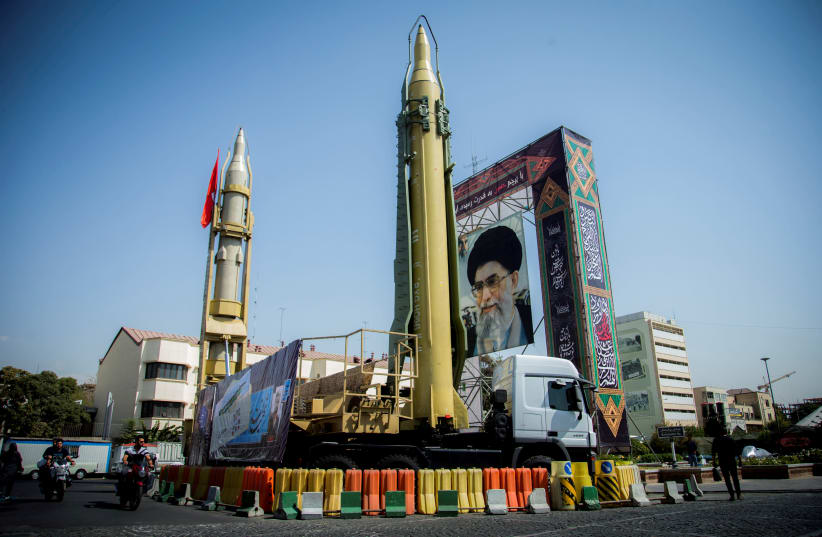Iran showed off an undamaged satellite on Saturday, days after a rocket exploded on its launchpad in the third failed launch of the year, which US President Donald Trump had tweeted about hours earlier.The United States has warned Iran against rocket launches, fearing the technology used to put satellites into orbit could help it develop the ballistic missile capability needed to launch nuclear warheads, though Tehran denies its activity is a cover for such development.On Friday, Trump posted on Twitter a photo of what appeared to be the site of a failed Iranian satellite launch, raising questions about whether he had disclosed US surveillance secrets.
Trump’s tweet added a layer of mystery to what happened, because even though it denies involvement, the very fact that he tweeted about it appears to reveal US interest in the explosion. Trump’s tweet is unusually technical, noting it was a Safir SLV Launch at Semnan Launch Site One. “I wish Iran best wishes and good luck in determining what happened at Site One.”On Saturday, reporters were shown the Nahid 1 (Venus 1) satellite at a state-run lab on Saturday, Iranian news agencies said.When asked about the explosion that led to the failed launch, Information and Communications Technology Minister Mohammad Javad Azari-Jahromi said the defense ministry should announce incident details, Iran’s semi-official Mehr News Agency reported.“But what we do know is that the Nahid satellite is still being prepared at the Iranian Space Research Institute,” he said.Earlier, in a Twitter post, Jahromi said, “Me & Nahid 1 right now. Good Morning Donald Trump!” along with a picture that purported to show him with the satellite.The rocket exploded on its launch pad on Thursday, an Iranian official had told Reuters, although Iranian media did not report the failed launch. A US official also said Iran suffered a satellite launch failure.The Safir rocket was first fired in 2009 and carried a satellite into orbit. The US has been upping sanctions on Iran as part of its maximum pressure campaign. A recent US cyber attack allegedly harmed Iran’s ability to target tankers. Trump’s tweet comes within that context, including a photo that appears to be a photo of a photo. The photo shows the destroyed rocket and damaged tower. It also shows damaged vehicles and a damaged Safir launcher that was attached to a mobile erector, one that could be driven to the site.It seems the photo was produced from a different image than the satellite and has more detail – and it appears that Trump or someone on his team took a photo of the image, which had been mocked up with the labels showing the launcher and debris. This may have been part of a briefing provided to the president.Trump’s tweet seemed designed to ratchet up the tension with Iran and imply the opposite of what the tweet said. Iran’s regime will now be left guessing if the destruction of their prestige rocket was more than an accident. It also raises questions about how images of the aftermath of the explosion circulated this week, beginning on Thursday.Up until Trump’s tweet, it was thought that the satellite might have spotted this through good luck or “sharp eyes.” It now appears to be something more.Trump’s tweet stirred controversy online because some suggested that the image might be classified or revealed intelligence that US intelligence agencies might not want out in public. A US defense official told CNBC that the image “appeared to be a snapshot of a physical copy of the satellite image” and that it was included in Friday’s intelligence briefing. The image had already been mocked up to indicate different elements in the frame. In addition, a map of Iran and a north arrow had been added. This was, therefore, not a raw intelligence image, it was one that had been prepared for the president or his team of advisers and officials.Nevertheless, questions remained about the level of detail in the image and why it differed from an earlier satellite image. Elements of Trump’s tweet suggest that it was not written in his normal tone and that the information was provided directly as the tweet was constructed, such as details about the “Safir SLV Launch at Semnan Launch Site One.”Previously, information on the Semnan site had called it the Imam Khomeini Space Center in Iran’s Semnan Province. The Nahid 1 satellite, which Tehran alleges to be a telecommunications satellite, was supposed to launch to an orbit of 250 km. from earth. It is not clear if the satellite itself survived the destruction. What is interesting is that details about the Semnan site appear in a book called Emerging Space Powers by Brian Harvey, Henk Smid and Theo Pirard, published in 2010.At the time, the site was less developed, but it still contained command and control, and trucks and a “transporter-erector,” as well as four lightning tours with flood lights. A Google image from earlier this year or a previous year showed the site had been painted and there was Farsi written on the launch pad area.The Trump image is a bit different; it shows that the pad has been painted again. A slogan meaning “national power” appears along one side of the launch area. It is so large that it is obviously intended to be seen from above, probably by satellites.Reuters contributed to this report.The United States of America was not involved in the catastrophic accident during final launch preparations for the Safir SLV Launch at Semnan Launch Site One in Iran. I wish Iran best wishes and good luck in determining what happened at Site One. pic.twitter.com/z0iDj2L0Y3
— Donald J. Trump (@realDonaldTrump) August 30, 2019
